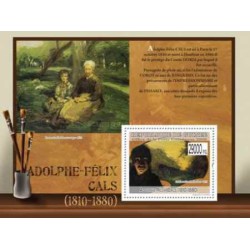- جدید
- ناموجود



توجه : درج کد پستی و شماره تلفن همراه و ثابت جهت ارسال مرسوله الزامیست .
توجه:حداقل ارزش بسته سفارش شده بدون هزینه پستی می بایست 100000 ریال باشد .
توجه : جهت برخورداری از مزایای در نظر گرفته شده برای مشتریان لطفا ثبت نام نمائید.

Gabriel Urbain Fauré (French: [ɡabʁiɛl yʁbɛ̃ fɔʁe]; 12 May 1845 – 4 November 1924)[n 1] was a French composer, organist, pianist and teacher. He was one of the foremost French composers of his generation, and his musical style influenced many 20th-century composers. Among his best-known works are his Pavane, Requiem, nocturnes for piano and the songs "Après un rêve" and "Clair de lune". Although his best-known and most accessible compositions are generally his earlier ones, Fauré composed many of his most highly regarded works in his later years, in a more harmonically and melodically complex style.
Fauré was born into a cultured but not especially musical family. His talent became clear when he was a small boy. At the age of nine, he was sent to a music college in Paris, where he was trained to be a church organist and choirmaster. Among his teachers was Camille Saint-Saëns, who became a lifelong friend. After graduating from the college in 1865, Fauré earned a modest living as an organist and teacher, leaving him little time for composition. When he became successful in his middle age, holding the important posts of organist of the Église de la Madeleine and director of the Paris Conservatoire, he still lacked time for composing; he retreated to the countryside in the summer holidays to concentrate on composition. By his last years, Fauré was recognised in France as the leading French composer of his day. An unprecedented national musical tribute was held for him in Paris in 1922, headed by the president of the French Republic. Outside France, Fauré's music took decades to become widely accepted, except in Britain, where he had many admirers during his lifetime.
Fauré's music has been described as linking the end of Romanticism with the modernism of the second quarter of the 20th century. When he was born, Chopin was still composing, and by the time of Fauré's death, jazz and the atonal music of the Second Viennese School were being heard. The Grove Dictionary of Music and Musicians, which describes him as the most advanced composer of his generation in France, notes that his harmonic and melodic innovations influenced the teaching of harmony for later generations. During the last twenty years of his life, he suffered from increasing deafness. In contrast with the charm of his earlier music, his works from this period are sometimes elusive and withdrawn in character, and at other times turbulent and impassioned.
Fauré was born in Pamiers, Ariège, Midi-Pyrénées, in the south of France, the fifth son and youngest of six children of Toussaint-Honoré Fauré (1810–85) and Marie-Antoinette-Hélène Lalène-Laprade (1809–87).[3] According to the biographer Jean-Michel Nectoux, the Fauré family (pronounced "Faoure" in the occitan local dialect) dates to the 13th century in that part of France.[4] The family had at one time been substantial landowners, but by the 19th century its means were reduced. The composer's paternal grandfather, Gabriel, was a butcher whose son became a schoolmaster.[5] In 1829 Fauré's parents married. His mother was the daughter of a minor member of the nobility. He was the only one of the six children to display musical talent; his four brothers pursued careers in journalism, politics, the army and the civil service, and his sister had a traditional life as the wife of a public servant.[3]
The young Fauré was sent to live with a foster mother until he was four years old.[6] When his father was appointed director of the École Normale d'Instituteurs, a teacher training college, at Montgauzy, near Foix, in 1849, Fauré returned to live with his family.[7] There was a chapel attached to the school, which Fauré recalled in the last year of his life:
I grew up, a rather quiet well-behaved child, in an area of great beauty. ... But the only thing I remember really clearly is the harmonium in that little chapel. Every time I could get away I ran there – and I regaled myself. ... I played atrociously ... no method at all, quite without technique, but I do remember that I was happy; and if that is what it means to have a vocation, then it is a very pleasant thing.[8]

An old blind woman, who came to listen and give the boy advice, told his father of Fauré's gift for music.[6] In 1853 Simon-Lucien Dufaur de Saubiac, of the National Assembly,[n 2] heard Fauré play and advised Toussaint-Honoré to send him to the École de Musique Classique et Religieuse (School of Classical and Religious Music), which Louis Niedermeyer was setting up in Paris.[13] After reflecting for a year, Fauré's father agreed and took the nine-year-old boy to Paris in October 1854.[14]
Helped by a scholarship from the bishop of his home diocese, Fauré boarded at the school for 11 years.[15] The régime was austere, the rooms gloomy, the food mediocre, and the required uniform elaborate.[9][n 3] The musical tuition, however, was excellent.[9] Niedermeyer, whose goal was to produce qualified organists and choirmasters, focused on church music. Fauré's tutors were Clément Loret for organ, Louis Dietsch for harmony, Xavier Wackenthaler for counterpoint and fugue, and Niedermeyer for piano, plainsong and composition.[14]
When Niedermeyer died in March 1861, Camille Saint-Saëns took charge of piano studies and introduced contemporary music, including that of Schumann, Liszt and Wagner.[17] Fauré recalled in old age, "After allowing the lessons to run over, he would go to the piano and reveal to us those works of the masters from which the rigorous classical nature of our programme of study kept us at a distance and who, moreover, in those far-off years, were scarcely known. ... At the time I was 15 or 16, and from this time dates the almost filial attachment ... the immense admiration, the unceasing gratitude I [have] had for him, throughout my life."[18]
Saint-Saëns took great pleasure in his pupil's progress, which he helped whenever he could; Nectoux comments that at each step in Fauré's career "Saint-Saëns's shadow can effectively be taken for granted."[19] The close friendship between them lasted until Saint-Saëns died sixty years later.[1] Fauré won many prizes while at the school, including a premier prix in composition for the Cantique de Jean Racine, Op. 11, the earliest of his choral works to enter the regular repertory.[14] He left the school in July 1865, as a Laureat in organ, piano, harmony and composition, with a Maître de Chapelle diploma.[20]
تشکر نظر شما نمی تواند ارسال شود
گزارش کردن نظر
گزارش ارسال شد
گزارش شما نمی تواند ارسال شود
بررسی خود را بنویسید
نظر ارسال شد
نظر شما نمی تواند ارسال شود

check_circle
check_circle















